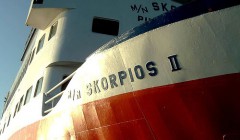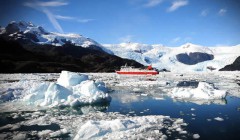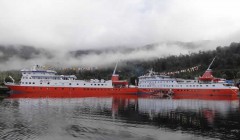- Skorpios II
- Skorpios II
- Skorpios II
Cruise Highlights
San Rafael Glacier
This «tidewater» glacier, the closest to the equator of any on earth, is located at 45°- 46° southern latitude, about 400 sea miles south of Puerto Montt. UNESCO declared the San Rafael National park a World Biosphere in 1979.
The glacier is roughly 30,000 years old; its directional flow is caused by pressure from the San Valentin ice field. Its icy path – around 15km/9mi long – finally ends at the San Rafael Lagoon, where it calves into the sea water. Along its front, the glacier is around 1.5mi wide, and its walls of ice rise over 80m/262ft out of the water. Below the surface, however, the ice continues down for another 230m/755ft. The colours of the ice vary from dark blue and light blue, to shades of green, to white, and grey.
Fjords, Mountains, Fishing, and Thermal Pools
Quitralco Fjord is surrounded by mountains and dense vegetation, and there are thermal pools that are exclusively accessible to the passengers of the Skorpios vessels. You have the opportunity to bathe in the pools, go on boat trips, fish, or simply stroll through untouched forests. The entire region is a nature reserve.
Chiloé Island
The routes followed by the Skorpios vessels lead past the fishing villages of Puerto Aguirre and Queilén, where you are welcomed during your visit. Chiloé’s capital of Castro is also a captivating stopping-point, with beautiful craftwork made from wood and wool available for purchase.
These latitudes boast an impressive range of flora and fauna: sea lions, gulls, ducks, dolphins, and many other fascinating animal species.
The unique wooden churches of Chiloé are also a UNESCO World Heritage.
- Tour Description
- Included Services
- Gear
- Notes
- Video
Departing from the Skorpios terminal, you pass the town of Calbuco, cross the Gulf of Ancud, traverse the entire archipelago of Chiloé, and cruise through the Gulf of Corcovado at around midnight.
Day 2 – Puerto Aguirre
The journey continues along the Moraleda and Ferronave Channels to the fishing village of Puerto Aguirre, where you can make a brief stop on shore. Your vessel departs at around 12.30pm, and journeys through the Ferronave, Pilcomayo and Costa Channels. Anchor is set about 30km/19mi from San Rafael Glacier.
Day 3 – Laguna San Rafael
An early morning departure through the Elephant Channel takes you to San Rafael Lagoon where, about one mile before reaching the glacier, you transfer to smaller boats, so that you can cruise along the multi-coloured ice formations and get daringly close to the glacier’s wall (depending on the weather). The journey to Quitralco Fjord continues towards the evening.
Day 4 – Thermal pools
You have the option of relaxing in a thermal pool after breakfast and, weather permitting, you can also explore the fjord by motorboat. The cruise continues towards evening, in the direction of Chiloé, travelling through the Moraleda and Pérez Norte Channels.
Day 5 – Chiloé Island
Today, the ship explores the Leucayec Channel, during which you will also see parts of Melinka Island while passing the Chonos Archipelago. Continuing the journey, you will travel through the Gulf of Corcovado, keeping close to the eastern seaboard of Chiloé Island. You will continue further through the Yal channel and the Castro estuary. At 15:00 hours you will arrive at the beautiful city of Castro, which you have time to explore on foot. At around 22:00 hours the ship will start sailing back toward Puerto Montt through Lemuy, Dalcahue and Quicavi channels. This evening you are invited to a Farewell Party with a Captain’s dinner.
Day 6 – Puerto Montt
Disembarkation is after breakfast, when you will leave with plenty of wonderful memories from your trip.
Listed excursions
Life wests are provided.





